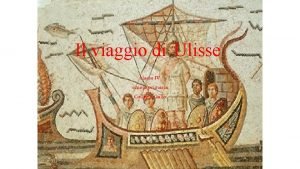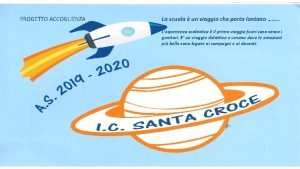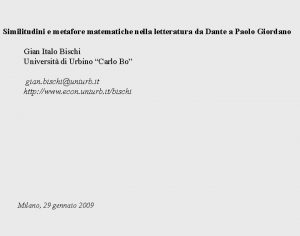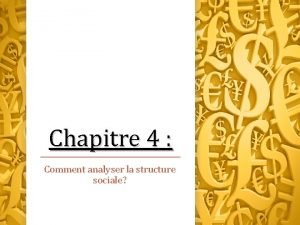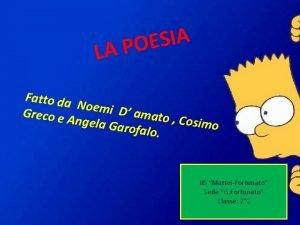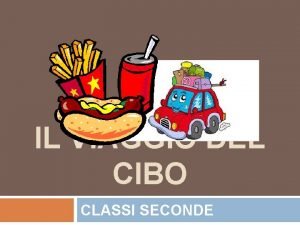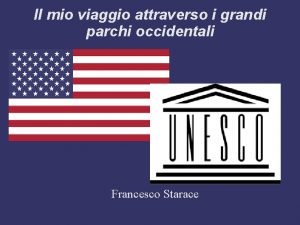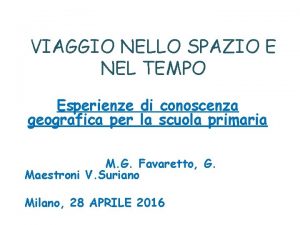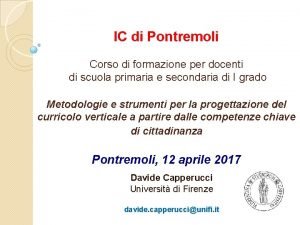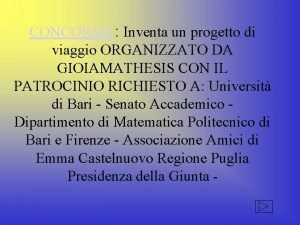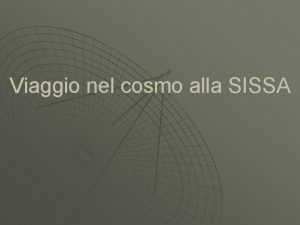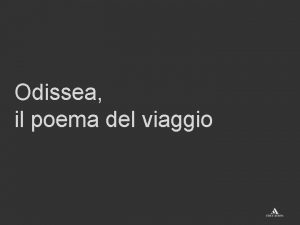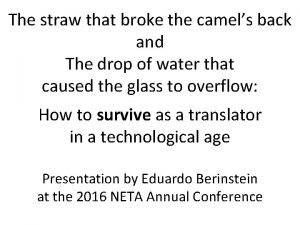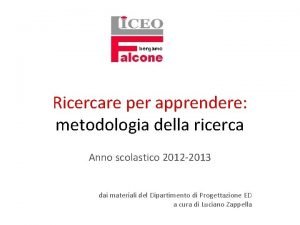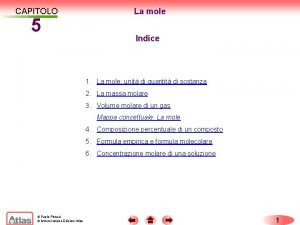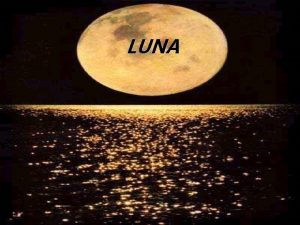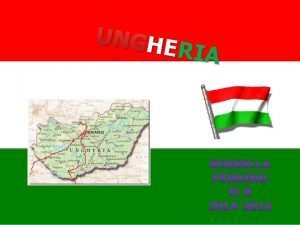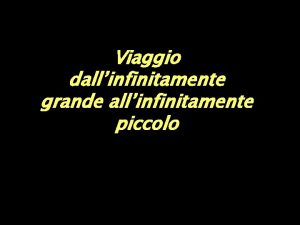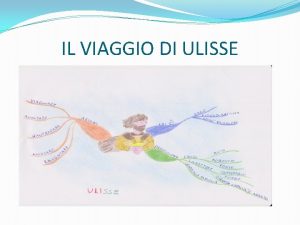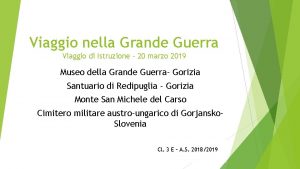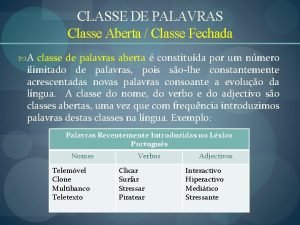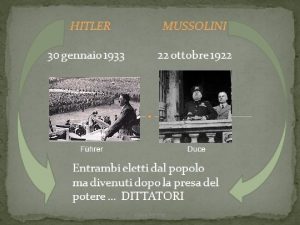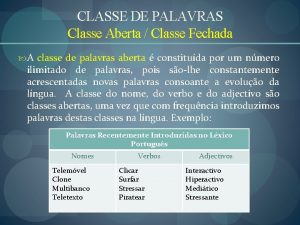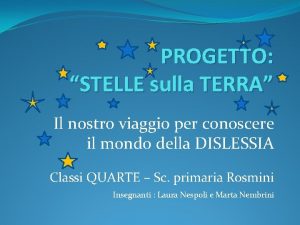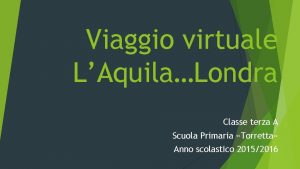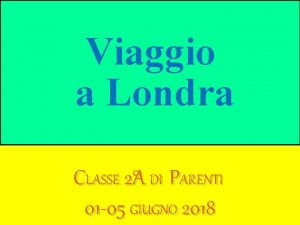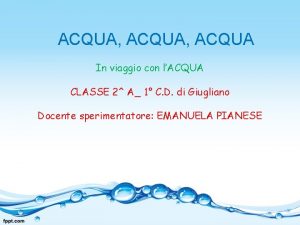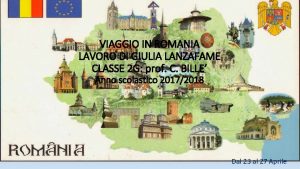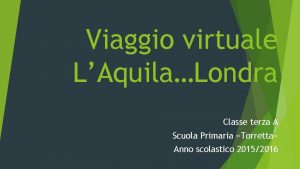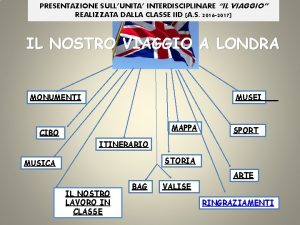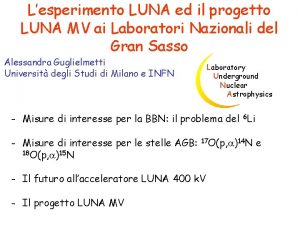VIAGGIO SULLA LUNA Classe 3D LA LUNA LA






















- Slides: 22

VIAGGIO SULLA LUNA Classe 3^D

LA LUNA


LA COMPETIZIONE SPAZIALE TRA STATI UNITI E UNIONE SOVIETICA Con la «guerra fredda» incominciò fra le due superpotenze anche la contesa spaziale: § Nel 1957, i Sovietici, lanciarono un satellite artificiale lo Spuntik 1 e un mese dopo lo Spuntik 2 con a bordo un essere vivente; § Nel 1958, gli Americani, lanciarono l’Explorer 1 § Nel 1961, i Russi, lanciaronocon il veicolo Vostok 1 con a bordo l’astronauta Yuri Gagarin § Nel 1962 l’americano John Glenn orbitò intorno alla terra § Nel 1963 una donna, la russa Valentina Tereshkòva ripeté l’impresa § Nel marzo 1965 un Russo, ancorato con un apposito cavo alla navicella «passeggiò» nello spazio.

Gli Americani «conquistano» la luna Il 20 Luglio 1969 la navicella spaziale americana, Apollo 11, «allunò» con a bordo due astronauti. Le immagini di Neil Amstrong, che per primo mise piede sul suolo lunare, fecero il giro del mondo. Dopo la luna ci furono altre esplorazioni nello spazio. Gli americani costruirono a basso costo lo Shuttle. I Sovietici il 15 dicembre 1970 fecero atterrare su Venere un veicolo spaziale, il Mars 3, che mandava segnali sulla Terra.

La «collaborazione spaziale» La stazione internazionale spaziale I costi elevati delle ricerche portarono Usa e Unione Sovietica a collaborare tra di loro. La collaborazione venne raggiunta e si concretizzò nel 2005 con la Stazione Internazionale Spaziale (ISS).

Life in space: the International Space Station Good morning, you are Frank Culbertson, aren’t you? Good morning, that’s right, I’m Frank Culbertson. Today I’m retired but I was the NASA commander on the International Space Station. 1) What is the International Space Station? The International Space Station is a laboratory for new technologies and an observation platform for astronomical, environmental and geological research. It travels around the Earth at an average speed of 27, 700 km/h. At night it can easily be seen from Earth, as it flies 320 kilometres above us. The USA, Russia, Japan, Canada and many European countries worked together to build the station and it was taken into space piece-by-piece and gradually built in orbit. 2) How big is it? It’s as big as an American football field, it has two bathrooms, a gym and a big window on space called “cupola” that was built in Italy. 3) Could you tell me what you usual eat there? Obviously, astronauts cannot grow their own food in orbit but an automated spacecraft arrives loaded with fresh fruit, water and pre-packed meals. However, space food is similar to that eaten everyday on Earth. 4) What do you do in your free time? We can play the guitar or the trumpet and we can listen to music.

La Luna nella poesia ALLA LUNA O graziosa luna, io mi rammento che, or volge l'anno, sovra questo colle io venia pien d'angoscia a rimirarti: e tu pendevi allor su quella selva siccome or fai, che tutta la rischiari. Ma nebuloso e tremulo dal pianto che mi sorgea sul ciglio, alle mie luci il tuo volto apparia, che travagliosa era la mia vita: ed è, né cangia stile, o mia diletta luna. E pur mi giovala ricordanza e il noverar l'etate del mio dolore. Oh come grato occorre nel tempo giovanil, quando ancor lungo la speme e breve ha la memoria il corso, il rimembrar delle passate cose, ancor che triste e che l'affanno duri! Giacomo Leopardi














 Il viaggio di astolfo sulla luna parafrasi
Il viaggio di astolfo sulla luna parafrasi Progetto ulisse scuola primaria
Progetto ulisse scuola primaria Progetto accoglienza il viaggio
Progetto accoglienza il viaggio Similitudini sulla luna esempi
Similitudini sulla luna esempi I seleniti continuano a stupire
I seleniti continuano a stupire Classe en soi et classe pour soi
Classe en soi et classe pour soi Classe en soi et classe pour soi
Classe en soi et classe pour soi Comment analyser la structure sociale
Comment analyser la structure sociale Geanta marco polo
Geanta marco polo Campo semantico viaggio
Campo semantico viaggio Diario di viaggio budapest
Diario di viaggio budapest Lo stomaco trasforma il bolo in una poltiglia detta chilo
Lo stomaco trasforma il bolo in una poltiglia detta chilo Il viaggio di ulisse disegni
Il viaggio di ulisse disegni Il mio viaggio ideale
Il mio viaggio ideale Somatopie cosa sono
Somatopie cosa sono Griglia di osservazione cooperative learning
Griglia di osservazione cooperative learning Skeppsholmen guida viaggio
Skeppsholmen guida viaggio Viaggio nel cosmo
Viaggio nel cosmo Il poema con polifemo
Il poema con polifemo Sergio viaggio
Sergio viaggio Larche guida viaggio
Larche guida viaggio Mappa concettuale sul viaggio
Mappa concettuale sul viaggio La mole mappa concettuale
La mole mappa concettuale

